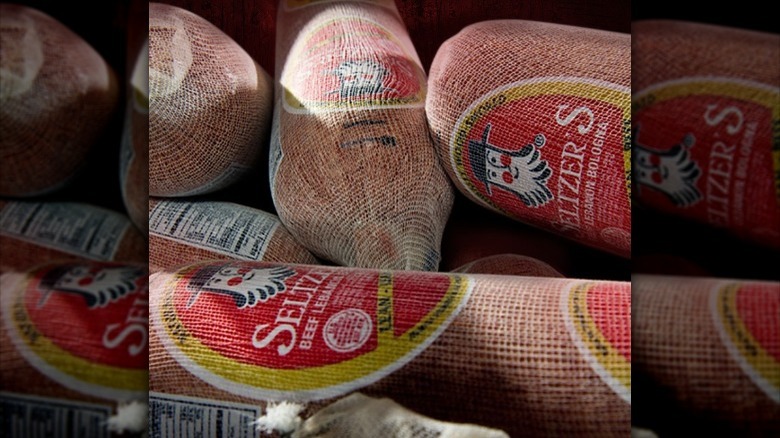Why Bologna From One Pennsylvania Town Is Unlike Any Other Variety
Many Americans may feel like they have an understanding of bologna. It's a savory processed meat that has come to top sandwiches at lunch counters and school cafeterias alike for decades. The more gastronomically inclined might even know that bologna is derived from the Italian cold-cut mortadella, which hails from the city of Bologna, per On The Gas. Even fewer may know of another variety of this lunch meat that hails from rural Pennsylvania — Lebanon bologna.
PA Eats points out that while the names may be similar, Lebanon bologna is a unique style of lunch meat. Webstaurant Store adds that the spice mixes between the two types of meat do tend to overlap, though that might be where the similarities end. Lebanon bologna is most often made with beef instead of pork like standard bologna, but it also has a different production method that gives it a unique flavor. Lebanon bologna is made by first fermenting, and then smoking the meat, per PA Eats. This gives it a different consistency that is closer to a hard Summer sausage, as well as a tangy and smoky flavor that makes standard bologna seem bland by comparison.
Lebanon bologna comes from the town of Lebanon, PA, per PA Eats. It is such an important symbol to the town, in fact, that a round of the famous meat has been lowered to help ring in the new year there for the last two decades. Its history in the region stretches back much farther.
History of Lebanon bologna
Lebanon bologna was originally produced by German immigrants that first settled in parts of eastern Pennsylvania. These peoples are commonly referred to as the Pennsylvania Dutch, per Taste, and settled into the area during the early 19th century. They brought their slow-curing sausage-making practices along with them but had to adapt them to local ingredients.
Pennsylvania Center for the Book claims that these early settlers were more dependent on meat for their nutrition than they were in their homeland. Because of this, they looked to cows and pigs to help feed them throughout the year. Farmers from throughout the area would then come together for a butchering day in which they harvested the meat. It was then fermented, smoked, and hung in their attics to dry. In the dry, relatively stable attics, the sausage would age safely and became a dish to consume throughout the year.
One of the oldest producers in the region, Seltzer's, still makes use of similar techniques to mass produce its Lebanon bologna today, via Pennsylvania Center for the Book. Instead of using stainless steel smoking chambers, its bologna is housed in a brick-lined smokehouse. A flame pit is dug beneath the hanging meats and is fed by hardwood for a natural, flavorful smoke.
How to enjoy Lebanon Bologna
Those looking to enjoy this tangy lunch meat can still easily get their hands on their own. Seltzer's, which has been in business since the 19th century and still uses its original recipe, has multiple varieties of Lebanon bologna available. Customers can buy whole 'chubs' of double-smoked, sweet, or original Lebanon bologna easily on its website.
Once you've got your hands on some Lebanon bologna, there are a variety of ways to enjoy it. It can easily be sliced and served as a unique feature of a charcuterie board. This is a great way to enjoy the bologna's unique flavor on its own. Webstaurant Store says that Lebanon bologna can be enjoyed in a similar manner to classic bologna. It can be used as the base of a deli sandwich, or wrap. It can also be a great way to add some variety to a Cobb salad.
Wide Open Eats adds that one of the classic ways to enjoy the smoked meat is in a pinwheel, or "keto sushi." This consists of smothering a slice of Lebanon bologna with cream cheese and rolling up some green chilies inside. This makes for a great tray of appetizers that most people will not be familiar with.


